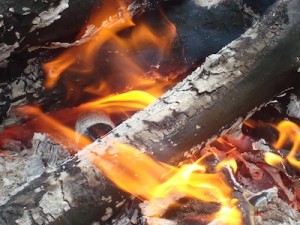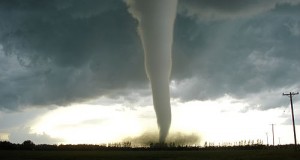As we discussed in the first part of this three-part fire series on survival, successful survival fires are one part materials, one part engineering, and one part monitoring.
Preparation for the site of your fire will be the first task, and you will want to ensure that you find a suitable location to place your fire. Will it be protected from wind? Is it in the right place relative to your shelter? Will you be able to obtain heat from its position? Will you have an ample supply of ongoing fuel?
 If you will be building a fire on wet, snowy, or icy ground, you will want to create a platform upon which to build your fire. To build this platform you will want to find “green” logs that are two to four inches in diameter and are relatively straight. Five to six of these logs, laid parallel to each other with no more than a couple inches in between them and another layer of them on top aligned perpendicularly with even less space in between them, should serve as a more-than-adequate base for your fire. All fire designs will work well on this platform; in fact, most of them will be bolstered, as it will provide additional airflow to the base the fire.
If you will be building a fire on wet, snowy, or icy ground, you will want to create a platform upon which to build your fire. To build this platform you will want to find “green” logs that are two to four inches in diameter and are relatively straight. Five to six of these logs, laid parallel to each other with no more than a couple inches in between them and another layer of them on top aligned perpendicularly with even less space in between them, should serve as a more-than-adequate base for your fire. All fire designs will work well on this platform; in fact, most of them will be bolstered, as it will provide additional airflow to the base the fire.
There are several fire types. They are all suitable for survival fires, but each will require some attention to detail and architecture. Perhaps the simplest and easiest to light is the teepee-type architecture.
The teepee—This is a triangle or cone-shaped design with the base wider than the top; the pieces are supported at the top by each other (leaning in on each other). It is made with one-to-two-inch diameter sticks, probably no longer than eighteen inches each—preferably one-and-a-half inches in diameter by twelve-to-fourteen inches long. In the interior space underneath the top intersection, you will arrange similarly structured (cone-shaped) kindling and a decent supply of additional tinder, as long as you can spare it. Within a few minutes of lighting your tinder, your kindling should be ablaze, which will eventually start funneling the bulk of the intensity of the fire at the conglomeration of sticks meeting at the point of the teepee. As the fire continues to grow or intensify, you can either add more sticks in the teepee formation or begin to structure larger, heavier pieces simply at an angle (with enough surface area over the bulk of the fire) to successfully light the pieces.
Pros: Burns fast and hot; lights easily; simple.
Cons: Uses a lot of fuel.
The log cabin—This is a teepee formation surrounded by four walls simply made by stacking alternating sticks in a square shape. With the teepee already built, you’ll take three-to-four-inch diameter logs (or the closest size you have available) at about twelve to eighteen inches long and place one on either side of the teepee. Two logs will initially form your base; on top of those logs at the ends, perpendicular and connecting those two logs, you’ll stack another two, which will build your second layer. Your third layer should mimic the first layer, perpendicular to the second layer, and your fourth should do the same as the second layer.
Pros: Can provide a good, stable structure for cooking, smoking, and drying; uses a little less wood than the teepee design.
Cons: Doesn’t generate as much heat.
The lean-to—This is a relatively straight, hearty green branch pushed into the ground at an angle between 25 and 40°, with dryer, thinner sticks laid against it from both sides. The main branch should be pushed into the ground with substantial force to at least six to ten inches in; it should be as green and live as possible, and the end that is not in the ground should be pointing in the direction of the wind so as to funnel the oxygen consumption from the lowest angle to the highest.
Pros: Simple structure; encourages oxygen activity.
Cons: Difficult to light at times; requires constant attention to fuel the fire.
The cross-ditch— Dig a shallow “X” shape in the ground, two to three inches deep with each leg of the “X” being approximately twelve-to-eighteen inches in length from the center of the cross. On the earth that is not dug out, make an “X”-shaped fire structure over the center of the original cross (crossing the “X” so the dugout area stays free of the fire). You will have a large dugout “X” shape with a small “X”-shaped fire build over the top of it in the opposite space which is not dug out. Underneath this second “X” in the very center of your dugout area, you will place your tender and kindling. Oxygen will funnel to the base of your fire via the dugout channels of the legs of the original “X.”
Pros: Somewhat conservative on fuel; relatively low maintenance.
Cons: Somewhat labor-intensive.
The star—Starting with a bundle of tender and kindling, you’ll build out from your bundle with five to six relatively substantial logs moving out in a starburst pattern from the center kindling.
Pros: Conservative on fuel.
Cons: Can be difficult to light initially without some attention to kindling.
The pyramid—Starting with two substantial base logs spread twelve to sixteen inches apart, you will add five to eight logs fairly closely spaced laying on top of these two logs and perpendicular to them. Each new layer will be perpendicular to the last layer, the spacing between the logs will be tighter, and the size will be smaller so as to create a modified pyramid design (larger at the base forming a “point” at the top). Underneath this pyramid you will light your kindling, which will have to be substantial in order to catch the logs on fire. Alternately (and this is the original intent of this architecture) you would light the top of the pyramid, which would eventually burn downwards, though you may need to monitor the burn for a while.
Pros: Somewhat conservative on fuel; relatively maintenance free after initial start.
Cons: Requires a substantial amount of wood; can be difficult to start with either top or bottom method.
The Dakota fire hole— Perhaps one of the most efficient methods for cooking or even for heating rocks or avoiding the adverse effects of smoke is the Dakota fire hole, a hybridized design. This is a one to three feet deep and one to two feet in diameter. In it you will build your fire, and it has a separate hole connecting underground to force-feed air to the base of the fire. If you intend to cook on the fire, you will want a shallower and smaller-diameter hole. The Dakota fire hole is windproof, easily concealable, and allows you to minimize the impact on the environment while simultaneously conserving fuel. It was originally put into widespread use in the military by downed pilots attempting to evade capture by enemy forces; however, arguably it has been around for centuries. Native tribes have used similar underground fire systems to serve as ovens for many years.
Generally speaking, the better the taper and the closer the angle of the second hole (the wind feeder hole) is to 45 degrees from the bottom of the larger hole (the fire containment hole), the hotter and cleaner the fire will burn, while also making a more complete burn. This method will minimize smoke and fuel waste.
*An important note: No matter which fire system you choose, you will want to find between fifteen and thirty fist-shaped and sized rocks for insulative purposes, both active and passive. Placed near the base of the fire, you can either use these to radiate heat from the fire while you sleep, or you can remove some and bury them shallowly in about four inches of sand or dirt beneath where you will lay, which will keep the ground from robbing precious body heat.
Ideally, you will also build a heat deflector out of green wood to ensure the majority of the heat put off by the fire deflects back towards you. This can be done by inserting many thin (one-to-one-and-a-half-inch thick) stakes “shoulder to shoulder” in two to three layers (eighteen to twenty-four inches high) to deflect back the heat. You can also lean/stack several three-to-four-inch thick logs on top of each other against a base of a couple of four-to-six-inch diameter logs (or two stakes driven into the ground).
In situations where you know your location will be somewhat stationary (for instance with an injured person in your party or awaiting rescue), you should consider building more substantial fire-deflection structures. A simple “L”-shaped wall could be constructed by driving two green straight sticks into the ground and aligning substantial logs in between them stacked up five to fifteen high. At each end of those logs, a new set of sticks will need to be driven into the ground on either side of the logs to support the wall. At the end of one set of logs you will place, at a right angle, a second wall.
Generally speaking, you will want five to ten times the amount of wood fuel as you anticipate needing. While this may seem like an over-the-top number, you must account for the amount of heat you will need to generate, the amount of time the fire will be burning while you sleep, the temperature and conditions, and the fuel necessary for heating food or boiling water. You can reduce the amount of fuel needed by using more conservative architectures or increasing the amount of rocks that surround your fire base (which will generate more heat without using precious fuel).
Any of these methods can provide adequate heat in any given scenario, assuming it’s built well from the beginning and has adequate fuel and airflow.
Always remember you will want to be careful with the amount of smoke funneled into your living area, as carbon monoxide poisoning is a silent killer and doesn’t take its time.
In the next segment, safety and usage considerations will be covered to complete this relatively comprehensive look at fire in a survival situation. As far as architecture and design goes, there isn’t one way better than the others, but there is almost always a “best way” depending on the situation you are in. Practice makes perfect, so perhaps it’s time to start practicing the methods you like.
©2011 Off the Grid News
 Off The Grid News Better Ideas For Off The Grid Living
Off The Grid News Better Ideas For Off The Grid Living



